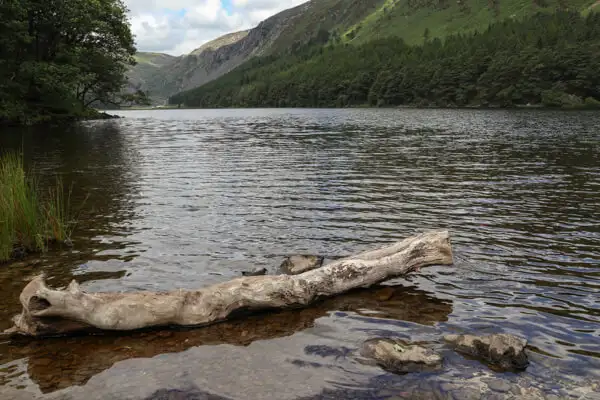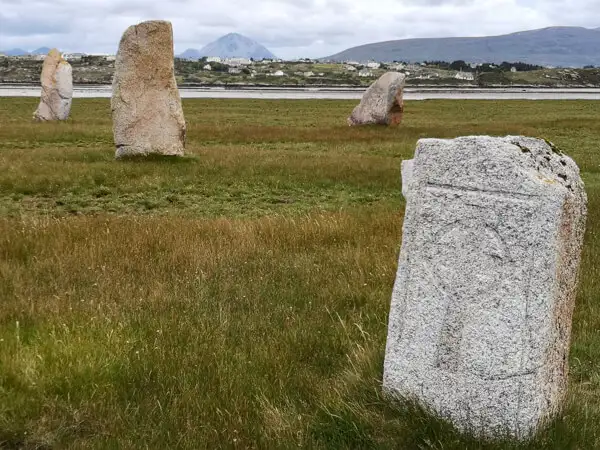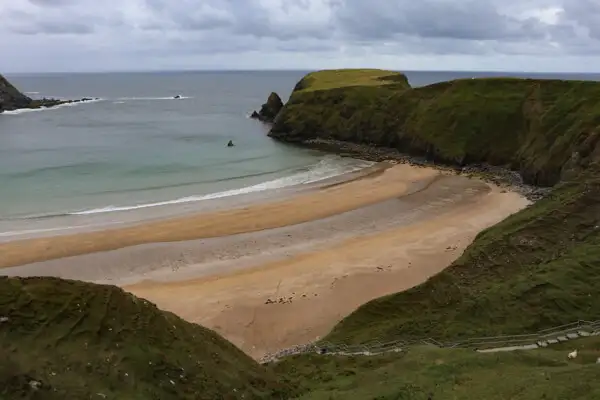The Irish were originally Celts – right? Partly – because the Irish themselves speak more of the Gaels and their language ‘Irish’ is derived from the old Gaelic. So, what’s this all about and where do the Irish come from?
Page Contents (click line to jump the text)
Origin of the Gaels and their arrival in Ireland
The Gaels are an ethnolinguistic group that emerged from the larger Celtic culture. Their origins can be traced back to the Late Bronze Age and Early Iron Age in Central Europe, when the Celts developed into one of the dominant cultures in Europe. However, Celts describes more a language group than a people as there were many very different tribes among the Celts.
It is thought that the Gaels first settled in western and north-western Europe, particularly in the British Isles and parts of the Iberian Peninsula, before reaching Ireland. The exact timing and nature of their migration remains controversial, but could have been in the period 600-700 BC.

However, this theory only explains one of presumably several waves of immigration, earlier ones of which may have had Celtic origins.
In Irish mythology, there is a theory that the Gaels originated from the Milesians, who descended from the Scythian horsemen from the Central Asian steppes. They then travelled to Ireland via Greece, Egypt and Spain. It is said that the Milesians could see the Irish coast from Spain and travelled there in their simple little boats.
A skeleton of a woman who had lived there around 5000 years ago was found near Belfast. Nearby, on Rathlin Island, skeletons were found of 3 men who lived here 3000-4000 years ago. Genetic studies show that all three came from early Anatolia. Immigration from the eastern Mediterranean region therefore seems likely.

A third and quite modern theory compares the monolithic cultures on the north-west coast of Spain with those in Brittany, the British Isles and Ireland and recognises strong similarities. The Galicians themselves refer to their Celtic heritage and also play the bagpipes, like the Scots.
There are also remains of megalithic cult sites, roundhouses and forts in Galicia, as there are throughout the British Isles and Ireland. The Galicians are believed to be descended from several Celtic groups from northern Europe.
What is certain is that the Galicians were very skilled fishermen and traded extensively in the Mediterranean and on the Atlantic coast with their simple sailing boats. They probably sailed via northern France, England and Scotland as far as Ireland.
However, the Galicians and their stone culture had already existed for a very long time before 700 BC, which means that this wave of immigration could have taken place much earlier, namely several thousand years earlier.

Wherever they came from, the Gaels in Ireland were probably made up of several immigrant groups from both the eastern Mediterranean and northern European Celtic tribes.
And the Celtic tribes were neither the first settlers in Galicia nor in Ireland, as there had already been people there since the Stone Age whose megalithic cultures were probably similar to those of the immigrating Celtic tribes. There was therefore probably an assimilation of the immigrant Celtic tribes with the existing people during the Neolithic and Bronze Age.
Yes, but how did people get to the islands before the Gaels? During the last ice age, Ireland and Scotland were still connected and there was a land bridge from the British Isles to the European continent.
So where did the Irish Celts come from? They probably originated from Neolithic settlers from the last Ice Age, mixed with sailing immigrant groups from the Bronze Age, one of which came from the eastern Mediterranean and another from Galicia, mixed with northern European Celts from the migration of peoples around 600 BC. At least some of these waves of immigration have Gaelic-Celtic origins from northern Europe. According to the researchers, it could have been like this, or…?

The society of the early Gaels
The Gaels from the 7th century BC brought with them an agrarian way of life that was dominated by cattle breeding and agriculture. They established a tribal society organised in small, independent kingdoms (tuatha). These kingdoms consisted of clans linked by blood ties and mutual obligations.
Later immigrant groups were also skilful blacksmiths who had learnt to work iron, which, due to its greater strength, replaced the previously dominant bronze in many areas, especially in the construction of agricultural implements and weapons.
Gaelic society was strictly hierarchical and strongly community-orientated. At its head was the king (rí), who was elected from the ruling family of a tribe. The king not only acted as a political leader, but also had ritual duties associated with the fertility of the land and the divine legitimisation of his rule.

Below the king there was an elite of warriors (féni), nobles and druids. The druids were of central importance and acted as religious leaders, jurists and scholars. They preserved the oral traditions, the sacred laws (Brehon Laws) and the Gaelic myths. The peasants and craftsmen formed the basis of society, while there was also a class of outsiders (déirb) who were regarded as outlaws or servants.
The religion of the Gaels was polytheistic and closely linked to nature. Deities such as Dagda, Lugh and Morrígan played an important role in their pantheon. Many of them were associated with certain landscape features such as rivers, mountains or sacred springs. Calendar festivals such as Samhain, Imbolc, Beltane and Lughnasadh were central elements of religious and agricultural life.

The political organisation of the Gaels was based on the small kingdoms (tuatha), which often consisted of only a few hundred families. Rule in a tuath was not an absolute monarchy, but was based on a complex system of mutual obligations between the king and the clans. Basically, it was a continuation of the old clan structures: family – clan (extended family) – regional king – high king.
Over time, some tuatha gained power and formed larger political entities known as supra-regional kingdoms.
Examples include the Kingdom of Connacht, the Kingdom of Ulster and the Kingdom of Leinster. These larger kingdoms vied for the symbolic role of the High King of Ireland (Ard Rí na hÉireann), who would reside at Tara, one of Ireland’s most important ceremonial centres.
However, the position of the High King was often more ritual than real. Actual power usually lay with the regional kings, who only entered into loose alliances with the High King.

The Christianisation of Ireland
The arrival of Christianity in the 5th century AD brought profound changes to Gaelic society. Missionaries such as St Patrick and Palladius introduced Christianity, which initially existed alongside the old Celtic traditions. Within a few centuries, however, Ireland became one of the most important Christian centres in Europe.
Christianity led to the foundation of numerous monasteries, which became not only religious but also cultural and educational centres. These monasteries produced some of the most impressive manuscripts in the medieval world, including the Book of Kells. At the same time, the monasteries adapted the Gaelic language and preserved many of the ancient myths and laws, which they reinterpreted in Christian contexts.

Christianisation also changed the social structures. The power of the druids diminished, while bishops and abbots took over the religious leadership. Nevertheless, the tribal structure remained and many clans maintained their independence despite the increasing association with Christian norms. See also my article on the Christianisation of Ireland: https://ireland-insider.com/how-christianity-came-to-ireland/.
The Viking Age and its impact
From the late 8th century AD, the Vikings began raiding Ireland. Initially, these raids were mainly directed against monasteries, which were rich in treasure and manuscripts. Later, the Vikings established permanent settlements on the coast, including Dublin, Waterford and Cork.
These towns became important trading centres, bringing new goods and cultural influences to Ireland. The Vikings also influenced the military and political structures of the Gaelic clans. Some clans co-operated with the Vikings, while others fought them.
In the 10th century, the High King Brian Boru led the Irish against the Vikings and won a symbolic victory at the Battle of Clontarf in 1014, although the Vikings largely retained their positions in Ireland. See also my article on the Vikings in Ireland: https://ireland-insider.com/history-of-the-vikings-in-ireland/.

The development of the Gaelic-Irish clans in the High Middle Ages
In the High Middle Ages, Ireland was dominated by a multitude of clans that were in constant conflict over land and resources. The clans consisted of extended families claiming common descent. Land was the most important economic asset and it was managed communally.
The Gaelic legal system, Brehon Law, governed property rights, inheritance and conflict. An important aspect of Brehon Law was its emphasis on equalisation and compensation rather than punishment. This legal system was flexible and adapted to local circumstances, which enabled the clans to survive despite constant conflict.

The clans were led by a Ceann Fine (clan chief), who was elected by the members of the clan. This election illustrates the semi-democratic nature of Gaelic society. The clans also cultivated alliances through marriage and political arrangements, but these were often unstable.
The decline of Gaelic order
With the arrival of the Anglo-Normans in the 12th century and the Tudor conquest in the 16th century, the decline of the Gaelic clans began. The Anglo-Normans introduced the feudalistic system, which was at odds with the communal land use of the Gaels. Nevertheless, many clans, especially in the western regions of Ireland, remained largely independent.
The defeat of the Gaelic lords at the Battle of Kinsale (1601) marked the end of Gaelic autonomy. Many clan chiefs were dispossessed, and the traditional structures of the clans were replaced by the English legal system. This event, known as the Flight of the Earls, led to the final destruction of the Gaelic order.
Despite these developments, the cultural heritage of the Gaels survived in the form of the Gaelic language, literature and music. This heritage became the basis of Irish national identity in the centuries that followed. See also my article on the Anglo-Norman invasion of Ireland: https://ireland-insider.com/the-norman-invasion-of-ireland/.
Conclusion
So are the modern Irish descended from Gaelic Celts from northern Europe? Yes!
And also from Neolithic settlers from the Ice Age, immigrants from Anatolia and Celtic fishermen and traders from Galicia.

Later came the Norse Vikings from Denmark, Sweden and Norway, as well as the Normans, who in turn descended from Vikings and northern Frenchmen, some of whom had Gallic-Celtic roots.
Later still, the English and Scots came to Ireland, especially in Northern Ireland and on the east coast.
The Scots and English descended from unknown Neolithic inhabitants, Celtic tribes from Cornwall, Wales or Scotland (the Picts) and Germanic Anglo-Saxons from Germany. The Angles came from Schleswig Holstein and the Saxons from eastern Germany. The Scottish Picts are probably related to the French Gauls.

Everything clear? It’s almost not confusing at all….
Despite all the confusion of the various immigrations and invasions of the island of Ireland, the Irish today refer strongly to their Gaelic heritage. Today’s ‘Irish’, the second official language alongside English, is derived from the old ‘Gaelic’, the language of the ‘Gaels’, the Gaelic Celts.
When people talk about ‘heritage’ in Ireland, a term that is often used in tourism, they are referring to the heritage or cultural origins of the Irish. In addition to the cultural buildings of the various eras, this also includes the linguistic and cultural heritage of the ‘Gaels’.

More interesting articles for you
The Norman Invasion of Ireland
Ireland’s history from the Stone Age to the Modern Age – an overview
How Christianity came to Ireland
History of the Vikings in Ireland
Drombeg Stone Circle – the megalithic heritage of Ireland
The Céide Fields – long before the Celts
Cover picture: Celtic mythical creature in the Book of Kells, photo: Ulrich Knüppel-Gertberg (https://irland-insider.de and https://ireland-insider.com)